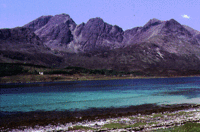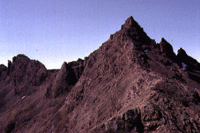Cuillin
|
|
The Cuillin are a range of rocky mountains located on the Isle of Skye in Scotland.
These are divided, visually and geologically into two distinct groups, the Red and Black Cuillin.
The Black Cuillin are mainly composed of basalt and gabbro, the latter being a very rough rock which makes for superb grip for mountaineers. It is from the dark colour of the gabbro that the Black Cuillin receive their name. The summits of the Black Cuillin are bare rock, jagged in outline and with many steep cliffs and deep cut corries and gullies. All eleven Munros on Skye are Black Cuillin peaks, though one of them, Blaven, is part of a group of outliers separated from the main ridge by Glen Sligachan.
The Red Cuillin are mainly composed of granitic rock which is paler than the gabbro (with a reddish tinge from some angles in some lights) and has weathered into more rounded hills with vegetation cover to summit level and many long screes slopes on their flanks. They are lower and, being less rocky, have fewer scrambles or climbs. Generally they receive less attention than their higher neighbours, and consequently the word Cuillin without a colour prefixed is usually taken to mean the Black Cuillin.
The highest point of the Cuillin, and indeed the Isle of Skye, is Sgurr Alasdair.The highest point of the Red Cuillin is Glamaig, one of only two Corbetts on Skye (the other being Garbh-bheinn, part of the small group of gabbro outliers surrounding Blaven).
The Black Cuillin are the most challenging hills in the British Isles, although the careful scrambler can access most of the individual peaks by their easiest routes. Only the Inaccessible Pinnacle is a graded rock climb by its simplest line but several of the other summits require rock climbing skills in order to ascend in safety.
In addition to climbing individual peaks and routes on the range, there is the challenge of a full traverse of the ridge. Although only 7 miles in length, the average traverse is likely to take 15–20 hours from sea level at Glenbrittle to the bar of the Sligachan Hotel owing to the difficulty of the terrain and route finding problems.
A further complication is the lack of any source of water on the ridge itself, meaning all water has to be carried in order to avoid any extra descent (and the consequent re-ascent).
In many ways, the ultimate mountaineering experience of the UK is the full traverse under winter conditions. Sadly the isle’s position in the warm Gulf Stream makes genuine winter conditions rare.
 Blaven, a Cuillin outlier |
 Sgurr nan Gillean with its tiny summit |
Missing image Marsco.JPG Marsco, in the Red Cuillin |

